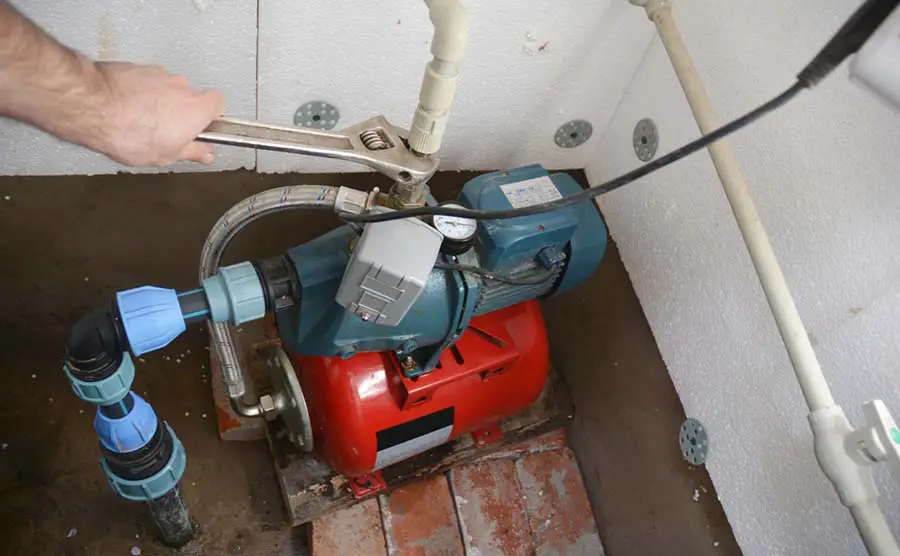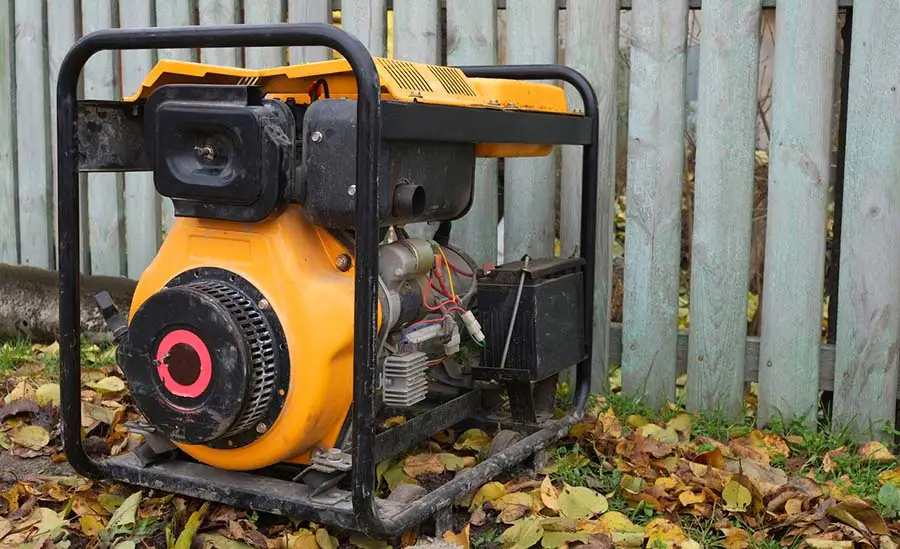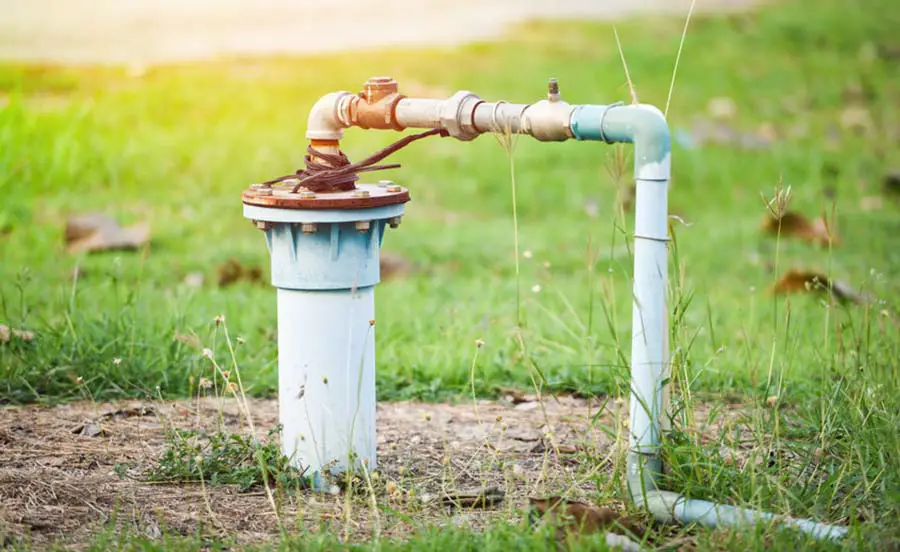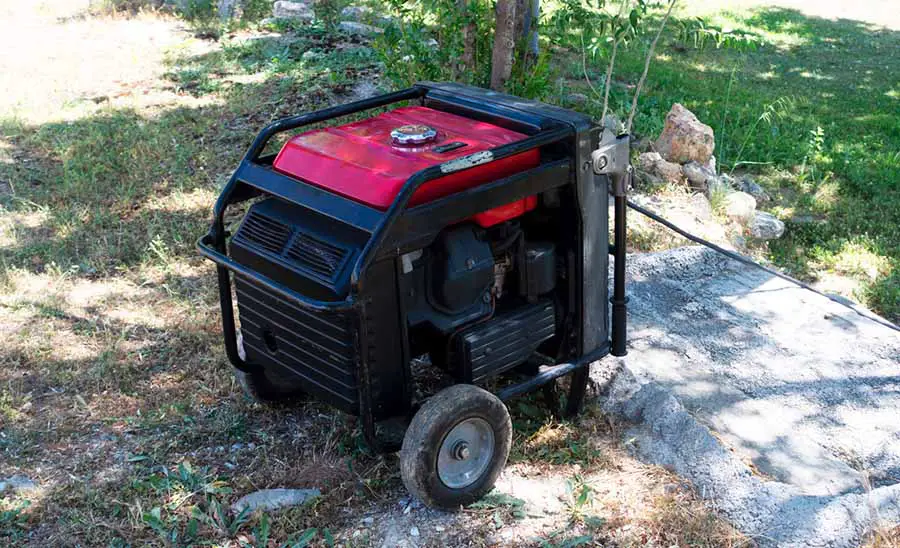
Portable generators are an integral part of our homes that come in handy during power outages. It is always nice to have a portable generator capable of powering most appliances in your home so you can live comfortably while the power is out. Running water is essential in most households hooked up to a well, so it begs the question, can a portable generator run a well pump?
If the well pump is not hardwired into your home’s electrical system and your generator can handle the load, you can run your well pump off a portable generator. A hardwired well pump needs a whole house generator, not a portable one, to run because connecting it during an outage is dangerous.
In this article, we look at generators, how to connect your generator to your well pumps, and offer suggestions on the best portable generator that will serve you best.
How Big of a Generator Do You Need To Run a Well Pump?
The size of a generator to use for powering your well pump is highly dependent on the size of your well pump.
Electric motors demand a lot of power to start and get to full speed. Remember that motors operate near maximum load. Once they achieve this optimum speed, their power demands reduce to those listed on the motor’s label.
For example, to run a standard submersible 1 Horsepower (HP) well pump, a 3-4 KW generator is needed to ensure that the motor starts well and easily attains maximum speed. The reasoning is that a 1 HP motor will only require 1 KW to 2 KW to run efficiently, but the starting and stalling wattages of such a motor are very large and may range from 3 KW to 4 KW.
This means that a 3500-watt motor is sufficient, but only if all other loads are disconnected to facilitate the starting of the motor.
A simple formula you can employ to determine the loading capacities of your generator is that the running wattage of your motor is double your motor’s horsepower, and the starting wattage of your motor is twice its running wattage.
A 3/4 HP well-pump will have a starting and stalling wattage of 3 KW and a running wattage of 1.5 KW. Similarly, a two-horsepower well-pump will have a starting and stalling wattage of 7.5 KW and a running wattage of 3.75 KW.
Can a Generator Burn Out a Well Pump?
A generator can burn out a well pump only if the generator malfunctions or gets slowed down due to burning dirty fuel or when the pump is frequently turned on and off or is poorly maintained.
When a pump is directly connected to a generator while bypassing the expansion tank, any fluctuation in the house water levels turns the generator on. These water level fluctuations may result from flushing the toilets or opening a faucet.
We can agree that this happens pretty much every time during the day. Now, imagine you turn on the motor at such high frequencies. With time, the motor performance decreases due to burnout.
Will a 3500-Watt Generator Run a Well Pump?
Yes. Most well pumps in our homes have a starting current of over 2,000 watts. It means that for a 3,500-watt generator, you can only run one pump at a given time.
The disadvantage is that you might have to sacrifice some appliances such as air conditioners within the house for the motor to run.
The hourly power consumption of air conditioners is about 318 watts in most homes. It translates to a power draw of anywhere between 1,800 and 2,500 watts per 9-hour period for an air conditioning unit. Too much power may overwhelm the generator when the pump and the air conditioning units are connected.
How Do You Hook Up Your Portable Generator To Your Well Pump?
Hooking up a portable generator to a good pump is a pretty easy task only if you know what you are doing.
If you’re not sure, please do not, at any cost, try to hook up the generator to a pump. Electricity is very dangerous, and you might end up blowing up your generator or motor, burning your house, or getting electrocuted.
However, if you’re well versed with electricity, the section below shall guide you on the steps necessary to hook up your generator to a pump.
- Disconnect your pump from the main power supply. It’s to avoid injecting twice the rated current into the motor coils as you might end up frying it.
- Assuming that you currently have your pump powered on by the mains supply, isolate the connections from the mains up until the pressure expansion tank since you don’t need to alter anything beyond the expansion tank relay unit.
- Fix a double-30-Amperes fuse unit on the wall next to your pressure expansion tank. This circuit breaker unit will protect the generator against backflow of excess current from the motor while also protecting the motor against surge currents from the generator.
- Run the two wires from the circuit breaker box to the pressure expansion tank and connect to the relay switch. Depending on the amount of water in the pressure tank, a relay switch will prompt the generator to turn the pump on or off.
- If you already had a pump connected to your pressure tank, as I would assume is the case in most homes, you leave it at this point.
- Go back to your circuit breaker box, and run two wires from the live terminals to the generator. Given that most well pump generators are 120 or 240 volts, these two cables shall each carry 120 volts with a maximum loading of 30 Amperes.
- Check for continuity from the generator plug to the relay switch. If your connection passes the continuity test, plug the cord into the generator and turn it on.
- Since this is a manually operated system, you can alternatively connect the mains and the portable generator circuits through a changeover switch.
Types of Well Pumps Compatible With Portable Generators

Not all homes have direct access to the municipal water system hence the need to drill wells close. The wells tend to be between 20 and 500 feet in depth, so manually drawing water from such a well is a hectic task. It necessitates the need for a pump within the homestead.
In this section, we’re looking at three pumps commonly found in most homes.
1. Submersible Pumps
As the name suggests, these pumps sit inside the wells. Made from extremely durable and rugged materials, they have an average lifespan of around 25 years.
Submersible pumps are the best for wells deeper than 25 feet since they are silent, move higher amounts of water per wattage, and develop higher household pressures than a jet or piston pump. They are also quiet and do not need priming.
As they sit just 4 or 5 feet from the bottom of the well, submersible pumps draw water through a grill into a discharge pipe, which pushes the water up the well into a pitless adapter that redirects water into the horizontal lines that then enter our homes.
Medium-to-large generators of more than 4,000 watts output rating are sufficient for deep-well submersible pumps.
2. Single-Drop Jet Pumps
Single drop jet pumps are housed above the well, and hence cheaper per unit power than their submersible counterparts. These pumps use impeller motors to develop suction and draw water from the bottom of the well.
Since they rely on suction, a single drop jet pump is only effective for wells that are shallower than 25 feet. Smaller portable generators of less than 3,500 watts can run a single drop jet pump well.
3. Double-Drop Jet Pumps
You can set jet pumps slightly differently to draw water from wells deeper than 25 feet. The jet assembly is found within the well in double-drop jet pumps, while the impeller unit is above.
A medium-to-large capacity generator of greater than 4,000 watts rating is required to run these pumps.
6 Best Portable Generators for Well Pumps

It’s frustrating to purchase a generator that fails when you need it the most. You don’t want to be without power and a generator during power blackouts due to storms or short circuits in the mains.
I’d recommend the following six very reliable portable generators for your well pump to avoid such scenarios:
| Generator Brand | Generator Model | Running Wattage |
|---|---|---|
| Champion | 71531 Duel Fuel | 7,500W |
| Honda | EU3000IS | 3,000W |
| Briggs & Stratton | 30664 | 8,000W |
| DuroMax | XP12000EH | 9,500W |
| Westinghouse | WGen7500DF Dual Fuel | 7,500W |
| DuroMax | XP4400EH Dual Fuel | 3,500W |
1. Champion 71531 CARB Compliant 9375-Watt Portable Generator
This 7,500 watt rated generator from Champion Power Equipment is a dual-fuel pioneer that allows you to run it on either unleaded gasoline or liquid propane. Switching between the two fuels while the generator is running is also possible as the generator uses a fuel selector.
Its 9,375-watt starting output easily lets you run most home appliances while the pump is on. It can also run at 50 percent load for 9 hours on a full tank of unleaded gasoline.
Champion is most proud of its “Intelli-gauge” feature. An Intelli-gauge avails data on the remaining operating time, hertz, and volts information. Plus, it has a two-year warranty!
Key Features
- dual fuel which can run simultaneously through a fuel selector
- durable frame with a portability kit
- two 120V duplex power outlets
- one 120/240V twist-lock repository
- one 120V twist lock, a low oil sensor
2. Honda EU3000IS 3000W 120V Portable Home Gas Power Generator

When it comes to machinery, Honda has made a name for itself in the industry, and its generators are no exception. This highly rated 3,000 watts generator has a running wattage of 2,800 watts and a 3,000 watts starting output.
Honda’s dedication to maximizing generator efficiency is very evident in this generator. It uses Honda’s Advanced Inverter technology to provide high wattage of very quiet and clean power.
Most people use this model in RVs and campers, but you can also use it to power home appliances. Due to its seemingly low 120 volts, 2,800-watt output, you can only use the generator to power small pumps of about 1 KW and below.
Key Features
- quiet
- fuel-efficient
- advanced inverter technology
3. Briggs & Stratton 30664 8000W Generator
Another fantastic alternative to the above-listed generators is Brigg & Stratton 30664 8,000-watt generator.
It is an OHV 420cc, 7.5-gallon tank generator that produces 25-percent more surge wattage to accommodate the starting of larger watt-hungry motors.
Its OHV 420cc engine has a starting torque of 10,000 watts, 66.6-surge amps capability, and produces 21-foot-pounds of torque for an impressive 9-hour run on a 50-percent load at a full tank.
Key Features
- can accommodate larger watt-hungry motors
- one 120/240-volts 30-amp outlet equipped with a circuit breaker
- four 120-volt outlets,
- an hour meter to monitor fuel levels
- key electric start
- super low-tone muffler
4. DuroMax XP12000EH Generator-12000 Watt Portable Generator
Another highly rated portable generator is the XP12000EH Generator from DuroMax. The XP12000EH features DuroMax MX2 technology that allows appliances to get the maximum 120V from each of the 120V outlets.
This generator made this list due to its powerful 457cc OHV engine that can power the generator for over a week. It is a strong generator that can be used for heavy water pumping while simultaneously running home appliances without stressing it.
Key Features
- starting wattage of 12,000 watts
- running wattage of 9,500 watts
- its engine can power the generator for over a week
5. Westinghouse WGen7500DF Dual Fuel Portable Generator
The WGen7500DF generator from Westinghouse is another excellent portable generator that generates sufficient power to power our homes.
Powered by a 420cc Westinghouse 4-stroke OHV engine, the WGen7500DF generates a 9,500 peak wattage and a 7,500 running wattage for gasoline, or 8,550 peak-wattage and a 6,750 running wattage for propane.
Key Features
- two GFCI 120V duplex outlets
- one 120/240V 30 A twist-lock outlet
- automatic low oil shutdown capability
- digital hour meter
- 9500 peak wattage
6. DuroMax XP4400EH Dual Fuel Portable Generator
The XP4400EH from DuroMax is a 3,500-watt lightweight generator best suited for small pumps. Powered by a powerful 208cc OHV, this generator has a peak wattage of 4,400 watts and 3,500 running wattage.
The generator has a fully-featured power panel with two 120V GFCI outlets, one 120/240 30A twist-lock outlet, DuroMax MX2 technology, a voltmeter, and a 12V DC charging port.
Key Features
- 4-stroke engine
- 12V DC charging port
- has a voltmeter
- suited for small pumps
6 Portable Generator Maintenance Tips
Purchasing a portable generator isn’t sufficient if you can’t manage it. Like any other appliance or machinery, routine maintenance of your portable transformer increases its lifespan while also ensuring that it performs efficiently.
Below are six portable generator maintenance tips you can perform.
1. Always Empty Your Generator Fuel Tank After Use
If the mains supply is back on, ensure that you empty your portable generator gas into a container.
Fuel oxidizes with time leading to deterioration, causing hard starting and leaving gum deposits on the sides of the tank. These gum deposits clog the fuel system, hindering the generator’s performance.
If you’d prefer to use your portable generator’s tank as storage, ensure that you fill it with fuel to the brim and add a fuel stabilizer to extend the fuel’s life.
2. Replace Old Engine Oil as Per the Manufacturer’s Recommendations
Engine oil maintenance is a crucial component of portable generator maintenance that people often neglect.
Old oil wears out and has weak lubrication capacity. Poor lubrication causes premature wear and tear of the engine parts, eventually leading to engine damage.
You must always check the state of the oil within the portable generator before turning it on. You should also use oil that has been recommended by the generator’s manufacturer or recommended by the Society of Automotive Engineering (SAE).
Ensure that you change the oil while the engine is warm to assure complete draining. Cold oil is viscous and tends to stick to engine parts.
3. Use a Transfer Switch Before Backfeeding Your Portable Generator
Using a portable generator to power a home is a common practice. It is very safe when proper preventive measures are employed while setting up the backup system. You should only backfeed a generator through a transfer switch.
Failure to do this can cause severe harm to your neighbors or any workers working on the line to restore electricity.
If the power returns and you still have your portable generator connected to the home circuits, there will be two conflicting power sources that supply excess current to your home.
However, since the generator power is less than the mains supply power, the generator is “forced” to act as a motor. It puts much strain on the generator, which may damage it or cause it to catch fire.
4. Ensure Your Generator Can Handle the Load
Excessive loading of the generator results in the tripping of the circuit breaker in a bid to protect the portable generator.
To avoid such a scenario, sum up all watt requirements of your appliances and compare them to what your portable generator can output. Connecting a smaller generator to a larger well pump can damage your generator.
5. Clean Your Portable Generator After Use
Proper maintenance of any equipment is incomplete without proper cleaning and storage. Most generator parts are constructed from metal that can rust.
To avoid rusting, clean your portable generator after use. Rust impedes the performance of your generator as it clogs pipes, adds impurities to fuel, and tampers with the structural integrity of the generator.
6. Start Your Portable Generator Up Once Per Month
Generators can sit idle for months or even years before you experience a power outage. During this time, most organic components such as oil and fuel are constantly deteriorating.
You might find yourself in a blackout only for your generator to fail. To avoid finding yourself in such a situation, ensure that you do monthly routine maintenance of the generator.
It involves starting it up to run oil through the engine, charging batteries (if present), and checking whether the carburetor is functional.
Conclusion
Getting a perfect portable generator for your home well pump isn’t as easy as walking into a store and picking an item. Before purchasing one, ensure that you’re well-versed with your motor’s power consumption, the generator’s fuel type, and structural integrity.
I’d recommend that you consult an electrician if you’re not well versed with electricity. Since electricity is dangerous, always follow standard safety precautions while dealing with portable generators.
